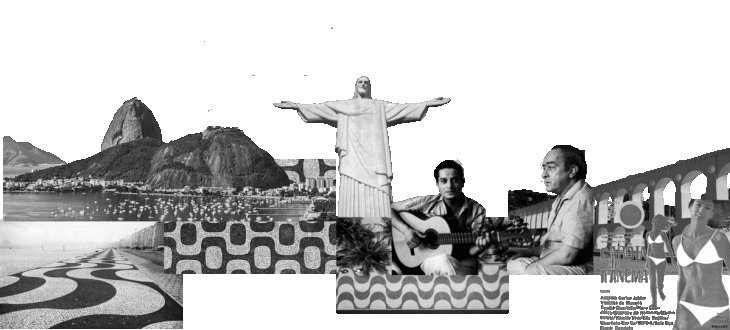
Favelas in Rio de Janeiro
A former Brazilian capital and the centre of a metropolitan area housing up to 12 million people is a major global city with rich and conflicting history, extensive cultural outreach and renowned tourist destinations. Unique coastal geography does not only define Rio’s picturesque landscapes, but also sets a strategic location for Brazil’s second largest port and one of the most brutal marketplaces in the entire history of slave trade with more than 900,000 African slaves disembarked and sold in the city until 1888.
The abolition of slavery, the following crises and demographic shocks accompanied by more than a century of policies of neglect gave birth to another dimension of Rio’s urbanity – the informal and uncontrolled mode of settlement – the favelas. Inhabited by the former slaves and later by the brutally segregated or evicted populations, this unique social clusters started occurring in the topographically challenging areas where the formal city could not yet reach. Forced to live in constant uncertainty and limited access to civic amenities, favelas managed to establish its own community-driven system of governance and development.
Constrained by steep forested hills and rigid formal structures of Rio de Janeiro favelas were able to accommodate their growth in organic and ever-changing flows of self-built structures and mazes of serpentine paths adapted to the hostile mountainous geographies. Left behind by the formal societal structures, underfunded and often undocumented, these settlements cannot be examined through the lens of conventional urbanism. The unique social landscape and unprecedented patterns of growth and self-management call for novel, specific and respectful research, as in-depth analysis and integrated development strategies can benefit both: the underserviced informal communities and the rigid formal urban systems.
Favela Taxonomy
Favelas are a unique settlement typology that do not follow the same logic and systematics as the formal city. Thus, in order to interpret this urban phenomena without trying to fit its organicity in a biased classical form, a new taxonomy was introduced to understand its form. Using the concepts developed by Paola Berenstein Jacques in the book “Estética da Ginga”1, the favelas were read through the lens of three concepts: the fragment – the single shelters build through time in the favelas; the labyrinth – as the residual space left by the congregation of many favela shelters and the rhizome – as the organic spread of the favelas in the city.

Paola Berenstein Jacques conceptual figures for interpreting favelas.
The Rhizome
Exploiting the concept of rhizome for interpreting the favela and also structuring the project’s strategy, the definition build by Deleuze and Guattari in the book “A Thousand Plateaus”2 was used to corroborate the idea of continuity and time dimension of urban settlements such as favelas.
- “The rhizome, […] is characterized by ceaselessly established connections between semiotic chains, organizations of power, and circumstances relative to the arts, sciences, and social struggles. Rather than narrativize history and culture, the rhizome presents history and culture as a map or wide array of attractions and influences with no specific origin or genesis, for a rhizome has no beginning or end; it is always in the middle, between things, interbeing, intermezzo.”
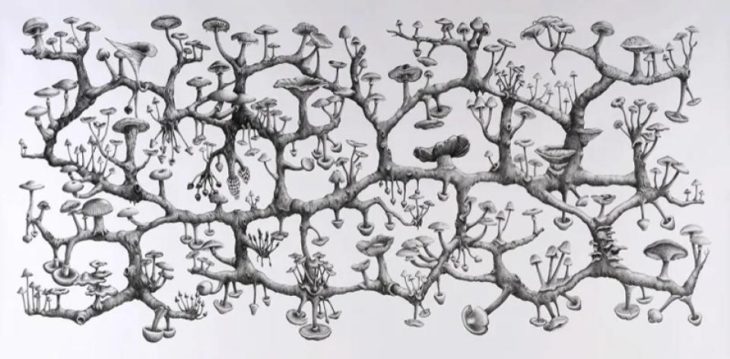
Richard Giblett Recent work : 2006-2009 Represented by Galerie Dusseldorf 21. Mycelium Rhizome, 2009
Contex Analysis
Rio de Janeiro consists of two main urbanized entities: the formal and the informal city. The formal city represents the urban tissue which is planned as an organized network in contradiction to the favelas, which have an organic tissue but also lack basic infrastructure services. An important element of our analysis is seeing the favelas as community-based societies with high levels of social vivacity, strong sense of belonging and distinct character.

Context Analysis
Conceptual Framework
These two worlds are in constant clash. The challenge is finding the way to connect the favelas between themselves as well as with the formal city – the grid and the rhizome – mix and bridge these two worlds. The core idea is to create new interfaces of interaction and concentration of these two communities. The new common spaces are aimed to connect the favelas with the city by promoting people’s choice, and drawing the expansion away from the protected landscape.

Conceptual Framework
The Clash in Rio
The favelas are generally located at the edge of the formal city of Rio de Janeiro, in dependence of job opportunities and access to all types of services. As the formal grid becomes saturated, the city expands, pushing the favelas further towards the protected green areas. This process creates what we recall as the Clash in Rio. The rhizomatic structure of these informal entities will support its progression, making it adaptive to steep slopes and hard topographies.
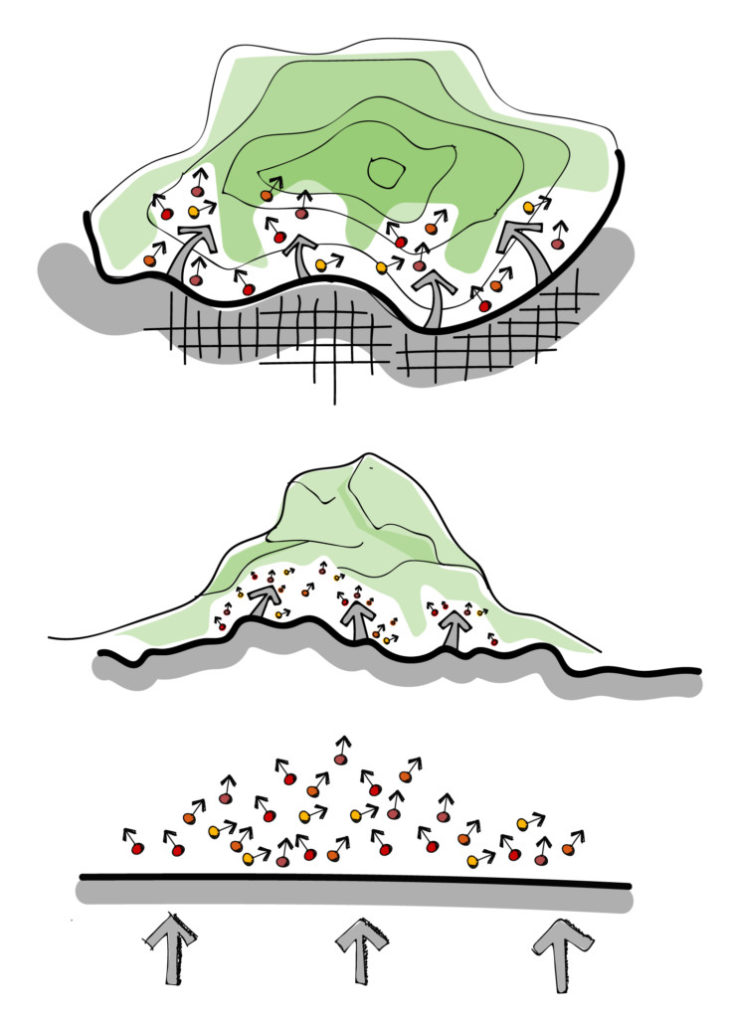
Clash Diagram
Favela Spread
With various configurations, scales and topographies, the favelas are spread all over Rio de Janeiro. They are the referential points in time and space that reflect the sequential history of the city’s urbanization. These fragments of informality house 25% of the total population of Rio de Janeiro, making it an important aspect of the cityscape.
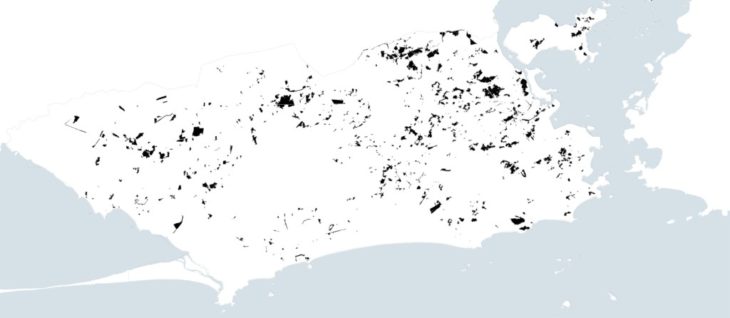
Favela Spread in the City
Interfaces
The conflict process lies in the interfaces of separation between the formal and the informal urban tissues, manifested in remarkable physical, social and economic barriers. The favelas appear as the buffer between the green protected areas and the expansion of the formal city.
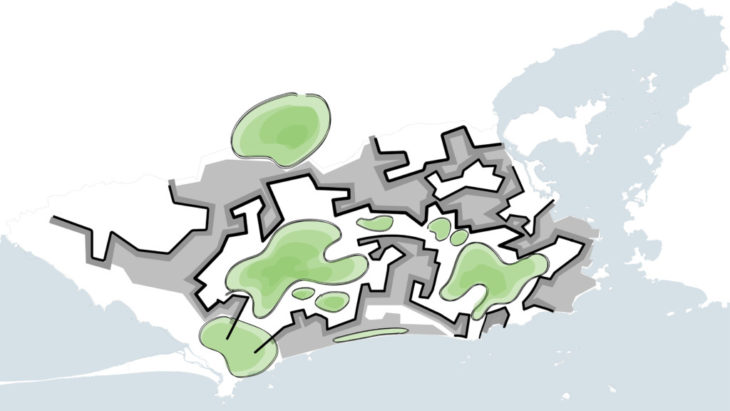
Interfaces
Potential Growth Patterns
A simulation of an imagined scenario for the uncontrolled escalation of the conflicted interface between the fluid growth of informal settlements and rigidity of the formal city.
Projected growth of favelas in the current scenario.
Strategy
Using the same taxonomy that Paola Berenstein Jacques created to interpret one favela, Favela Flows exploits these concepts into a broader scenario: the whole city. Thus, one favela is interpreted as fragment, a complex of favelas as labyrinth and the relation between these with the city as rhizome. The strategy aims to generate new drivers of connectivity in between the fragments and the grid. The focus of the new interrelationships is to enhance the labirinth and, further on in time, dissolve the existing segregative barriers between favelas and the formal urban dynamics.

Strategy Diagram
Favela Flows
Conceptualizing a large-scale future scenario, the favelas are no longer interpreted as spread fragments in the city, but now, as rhizomatic structures that root themselves in the grid. The Favela Flows – new connected super-favelas – are now integrated in the grid, as a valid stakeholder in the urban dynamics.
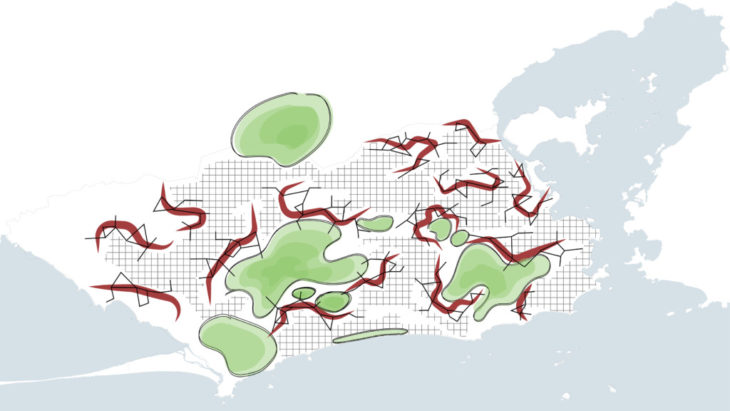
Favela Flows
Future Scenarios
The proposed connections created by Favela Flows could become punctual solutions for dissolving the existing barriers. These new spaces are tackling some present issues concerning the favelas. Nature based solutions could be used in order to mitigate the favela’s expansion towards green protected areas and preserve the landscape; new civic and leisure facilities are an options when it comes to creating spaces to mingle two different facets of the society; and new mobility infrastructure comes to support the needs of physical accessibilty for the favelas.
From left to right: nature based solutions, sports facilities and new mobility systems.

References:
1 – Jacques, P. (2011). Este?tica da ginga.
2- Deleuze, G. (2003). A thousand plateaus: Capitalism and schizophrenia. Continuum.
Favela Flows is a project of IAAC, Institute for Advanced Architecture of Catalonia developed Master in City and Technology in 2021/2022
Students: Dimitrios Lampriadis, Joseph Bou Saleh, Maria Augusta Kroetz and Robert Yussef
Faculty: Manuel Gausa and Nicola Canessa